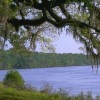Abstract
Many uses of the Apalachicola-Chattahoochee-Flint river basin depend on how the US Army Corp of Engineers operates dam releases from the reservoirs when managing lake levels and downstream river flows and water levels. However, no single set of protocols equally suited to all uses and demands governs the reservoir releases. The purpose of this publication is to describe how the USACE manages reservoirs and dams in the ACF and how the waters in the basin are used. This 6-page fact sheet was written by Christopher J. Martinez and published by the UF Department of Agricultural and Biological Engineering, March 2013.
References
Bleakly Advisory Group, Inc., Seaman, B.A., and PBS&J. 2010. Lake Sidney Lanier Economic Impact Analysis. Final Report. Prepared for the 1071 Coalition. Accessed February 2013. http://lakelanier.org/wp-content/uploads/2012/03/Lake-Lanier-Economic-Impact-Analysis-Final-Report.pdf.
Bryan, C.H., and S. Rose. 2006. "Stakeholder Issues in the ACT and ACF Systems." In Interstate Water Allocation in Alabama, Florida, and Georgia, edited by J.L. Jordan and A.T. Wolf, 30-48. Gainesville: University Press of Florida.
Couch, C.A., E.H. Hopkins, and P.S. Hardy. 1996. Influences of Environmental Settings on Aquatic Ecosystems in the Apalachicola-Chattahoochee-Flint River Basin. U.S. Geological Survey Scientific Investigations Report 95-4278. http://pubs.usgs.gov/wri/wrir95-4278/.
Hook, J.E., K.A. Harrison, G. Hoogenboom, and D.L. Thomas. 2005. Ag Water Pumping: Final Report of Statewide Irrigation Monitoring. Project Report 52. EPD Cooperative Agreement Number: 764-890147, UGA ID 25-21-RF327107. Atlanta, GA: Ga. Geol. Survey, Envir. Protection Div. http://www.nespal.org/SIRP/AWP/AWP_I_Final_Report. shtml.
Marella, R.L., and J.L. Fanning. 2011. Water Withdrawals, Wastewater Discharge, and Water Consumption in the Apalachicola-Chattahoochee-Flint River Basins, 2005, and Water-Use Trends, 1970-2005. U.S. Geological Survey Scientific Investigations Report 2011-5130. http://pubs.usgs.gov/sir/2011/5130/. https://doi.org/10.3133/sir20115130
United States Army Corps of Engineers (USACE). 2012a. 2012 ACF Basin Composite Conservation & Flood Storage. Accessed May 2012. http://water.sam.usace.army.mil/ACFconstorage.pdf.
USACE. 2012b. How the River Systems Are Managed. Accessed May 2012. http://water.sam.usace.army.mil/narrativ.htm.
USACE. 2012c. Lake Sidney Lanier. Accessed May 2012. http://www.sam.usace.army.mil/Missions/CivilWorks/Recreation/LakeSidneyLanier.aspx.
United States Fish and Wildlife Service (USFWS). 2008. Description of Proposed Action Modification to the Interim Operations Plan at Jim Woodruff Dam. Accessed February 2013. http://www.fws.gov/southeast/drought/pdf/ProposedActionDescription-ModificationIOP.pdf.
USFWS. 2012. "Biological Opinion on the U.S. Army Corps of Engineers, Mobile District, Revised Interim Operating Plan for Jim Woodruff Dam and the Associated Releases to the Apalachicola River." U.S. Fish and Wildlife Service News Release. Accessed February 2013. http://www.fws.gov/southeast/news/2012/027.html.
Unless otherwise specified, articles published in the EDIS journal after January 1, 2024 are licensed under a Creative Commons Attribution-NonCommercial-NoDerivs 4.0 International (CC BY-NC-ND 4.0) license.

